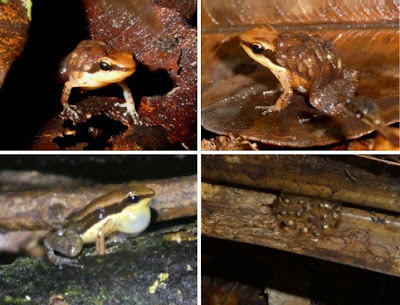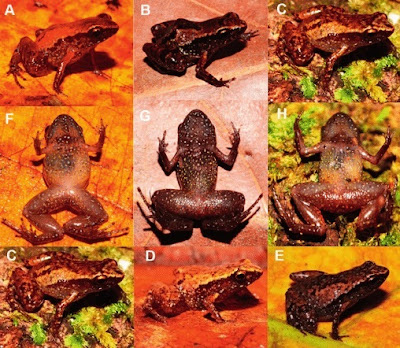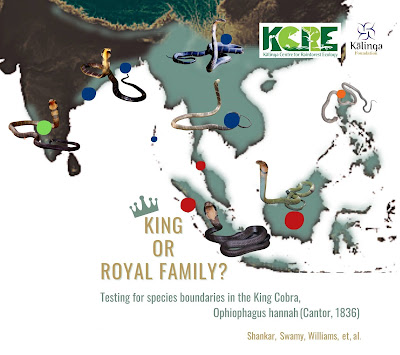[Most Recent Entries] [Calendar View]
Thursday, September 2nd, 2021
| Time | Event | ||
| 3:12a | [Botany • 2021] Phanera laotica & P. rubra (Leguminosae: Cercidoideae) • Two New Species of Phanera from Lao PDR
Summary Two new species of the genus Phanera, Phanera laotica Mattapha & Lanors. and P. rubra Lanors. & Mattapha, are described and illustrated. Their taxonomic affinities are discussed. They were discovered in central Lao PDR and are assessed here as endemic and rare species. Key Words: Bauhinia, Indo-China, Leguminosae, taxonomy Phanera laotica Mattapha & Lanors. sp. nov. Type: Laos, Bolikhamxai province, Paksan distr., ... ETYMOLOGY. The specific epithet refers to the country, Lao PDR, where the species was discovered and found as endemic. Phanera rubra Lanors. & Mattapha, sp. nov. Type: Laos, Xaysomboun province, Longxan distr., Phou Khao Khouay National Protected Area, ... ETYMOLOGY. The specific epithet “rubra” refers to the reddish flowers. Sawai Mattapha, Soulivanh Lanorsavanh, Vichith Lamxay and Khamfa Chanthavongsa. 2021. Two New Species of Phanera (Fabaceae: Cercidoideae) from Lao PDR. Kew Bulletin. DOI: 10.1007/s12225-021-09964-1 | ||
| 4:00a | [Herpetology • 2021] Allobates grillicantus • A New Nurse Frog (Anura: Aromobatidae) with a Cricket-Like Advertisement Call from Eastern Amazonia
Abstract Integrative analyses, long-term studies, and access to remote areas in Amazonia have led to new hypotheses and increased resolution of the systematics and taxonomy of the small nurse frog genus Allobates (family Aromobatidae). During anuran sampling in the Middle Tapajós River region, state of Pará, Brazil, we collected data on a new cryptically colored species of Allobates with a cricket-like advertisement call. Here, we name and describe this new species, following an integration of phenotypic, ecological, and molecular analyses. The results of a phylogenetic analysis based on mitochondrial and nuclear DNA placed the new species as the sister taxon of Allobates grillisimilis. Genetic pdistances between the two sister taxa at the 16S region of the mitochondrial DNA ranged from 7% to 9%. A sister-species relationship between the new species and A. grillisimilis is also supported by phenotypic evidence. Adults of the new species are small (snout–vent length 15.2–16.8 mm in males and 16.5–17.7 mm in females), with a dorsum uniformly tan to reddish brown, a dark brown lateral stripe and a white ventrolateral stripe, arms pale tan brown and legs greyish-brown, and venter yellowish colored, with variable extension and shades of yellow, paler on the throat. The advertisement call is a trill with a mean peak frequency of 5830.2 Hz, arranged in series of short, closely spaced, pulses (mean of 24.3 pulses/s), and followed by silent intervals of variable duration. We discuss the putative drivers generating and maintaining the distinctiveness between the new species and the allopatrically distributed sister taxon, and on threats to the persistence of the new species. With this species description, the Middle Tapajós River region is consolidated as having one of the highest alpha diversities for the genus Allobates in Amazonia. Key words: Anura; Bioacoustics; Biogeography; Brazil; Conservation; Cryptic diversity; DNA; Integrative taxonomy; Para Allobates grillicantus sp. nov. Etymology.— The specific epithet grillicantus means ‘‘cricket song’’ and refers to the cricket-like advertisement call emitted by this species. It is a compound Latin noun in the nominative case used in apposition, derived from gryllus ,meaning ‘‘cricket’’ and cantus, meaning ‘‘song.’’ The name is purposely similar to the sister taxon A. grillisimilis to refer to common ancestry. Leandro J.C.L. Moraes and Albertina P. Lima. 2021. A New Nurse Frog (Allobates, Aromobatidae) with a Cricket-Like Advertisement Call from Eastern Amazonia. Herpetologica. 77(2); 146-163. DOI: 10.1655/Herpetologica-D-20-00010.1 | ||
| 4:15a | [Herpetology • 2021] Adelophryne nordestina • A New Species of the Genus Adelophryne (Anura: Eleutherodactylidae: Phyzelaphryninae) from the Atlantic Forest of Northeastern Brazil
Abstract Species in the Adelophryne genus consist of diminutive, agile, and secretive frogs that inhabit forest leaf litter and have direct development. Species richness within Adelophryne was previously underestimated, and several new species have recently been described. Here, we describe a new species of Adelophryne from the Atlantic Forest in the Brazilian states of Alagoas, Pernambuco, and Paraíba. The new species is characterized by its small body size, small and distinct tympanum, toes with subarticular tubercles, fingers mucronate, three phalanges in the Finger IV, and an advertisement call composed of one single pulsed note with a high dominant frequency. The new species is phylogenetically related to other Adelophryne species of the Northern Atlantic Forest Clade and is endemic to the “Pernambuco Endemism Center” in the Atlantic Forest biodiversity hotspot. Keywords: Alagoas, Amphibia, biodiversity, hotspot, miniature, Paraíba, Pernambuco Ricardo Lourenço-De-Moraes, Barnagleison Silva Lisboa, Leandro De Oliveira Drummond, Carina Carneiro De Melo Moura, Geraldo Jorge Barbosa De Moura, Mariana Lúcio Lyra, Miriam Camargo Guarnieri, Tamí Mott, Marinus Steven Hoogmoed and Diego José Santana. 2021. A New Species of the Genus Adelophryne (Anura: Eleutherodactylidae: Phyzelaphryninae) from the Atlantic Forest of Northeastern Brazil. Herpetologica. 77(2); 164-175. DOI: 10.1655/Herpetologica-D-20-00022.1 | ||
| 4:07p | [Herpetology • 2021] King or Royal Family? Testing for Species Boundaries in the King Cobra, Ophiophagus hannah (Cantor, 1836) (Serpentes: Elapidae), using Morphology and Multilocus DNA Analyses Highlights • We performed an integrative species delimitation analysis of the iconic king cobra (Ophiophagus hannah) across its range in the Oriental realm. • Mitochondrial and nuclear gene sequences and morphology support the recognition of four independently evolving lineages. • The boundaries of four delimited lineages are broadly coincident the following biogeographic sub-regions: Western Ghats, Indo-Chinese, Indo-Malayan and Luzon island (Philippine archipelago) Abstract In widespread species, the diverse ecological conditions in which the populations occur, and the presence of many potential geographical barriers through their range are expected to have created ample opportunities for the evolution of distinct, often cryptic lineages. In this work, we tested for species boundaries in one such widespread species, the king cobra, Ophiophagus hannah (Cantor, 1836), a tropical elapid snake distributed across the Oriental realm. Based on extensive geographical sampling across most of the range of the species, we initially tested for candidate species (CS) using Maximum-Likelihood analysis of mitochondrial genes. We then tested the resulting CS using both morphological data and sequences of three single-copy nuclear genes. We used snapclust to determine the optimal number of clusters in the nuclear dataset, and Bayesian Phylogenetics and Phylogeography (BPP) to test for likely species status. We used non-metric multidimensional scaling (nMDS) analysis for discerning morphological separation. We recovered four independently evolving, geographically separated lineages that we consider Confirmed Candidate Species: 1) Western Ghats lineage; 2) Indo-Chinese lineage 3) Indo-Malayan lineage; 4) Luzon Island lineage, in the Philippine Archipelago. We discuss patterns of lineage divergence, particularly in the context of low morphological divergence, and the conservation implications of recognizing several endemic king cobra lineages. Keywords: Species delimitation, king cobra complex, endemic, Western Ghats, phylogenetics, phylogeography P. Gowri Shankar, Priyanka Swamy, Rhiannon C. Williams, S. R .Ganesh, Matt Moss, Jacob Höglund, Indraneil Das, Gunanidhi Sahoo, S. P. Vijayakumar, Kartik Shanker, Wolfgang Wüstere, and Sushil K. Dutta. 2021. King or Royal Family? Testing for Species Boundaries in the King Cobra, Ophiophagus hannah (Cantor, 1836), using Morphology and Multilocus DNA Analyses. Molecular Phylogenetics and Evolution. In Press, 107300. DOI: 10.1016/j.ympev.2021.107300 |
| << Previous Day |
2021/09/02 [Calendar] |
Next Day >> |
















